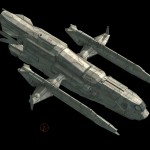Kurt Hollowell formed Dog Eat Dog Games in 2014 as a two-man studio – today the Albuquerque based team has grown in size but remains focused on creating games in established genres with differentiated mechanics to offer players unique experiences.
One of those contributions is Stellar, a space exploration shooter where the player can shift the dimension from 3D to 2D seamlessly. After the transition, enemy behavior changes, the environment adapts and the entire experience is shaped by which view the player enters.
During MomoCon 2015, I had a chance to play a beta-version of Stellar and meet the Dog Eat Dog Games team. When I first started playing, the 3D space enviroment was intuitive to navigate, exploring through space debri and getting a feel for how the ship maneuvered in the environment. The first enemy appeared and was extremely difficult to land a hit on – by the time reinforcements arrived I felt battered and like I had no idea how to play the game.
Hollowell suggested I change the perspective to 2D (maybe I should have read the tutorial fully) and the world instantly flattened. Now the game was more akin to Asteroids than a flight simulator. Enemy behavior was easier to predict and shots could be lined up for devastating effect. During an interview with Hollowell he indicates that this is all by design.
 “Each enemy has an advantage in a different dimension. If you pick the right perspective they are squished in that same perspective. If you had a ship that was circling around the Y axis, they’ll be locked in that plane and can’t circle around but if you did the X, he could still circle.”
“Each enemy has an advantage in a different dimension. If you pick the right perspective they are squished in that same perspective. If you had a ship that was circling around the Y axis, they’ll be locked in that plane and can’t circle around but if you did the X, he could still circle.”
Choosing which dimension to explore, fight enemies and conquer the galaxy isn’t just a gimmick within Stellar, it is a new aspect of gameplay that the player must always be considering. The main campaign of Stellar is that the the player’s alien race manipulates space between 2D and 3D in order to rule over the known galaxy.
Hollowell describes the story as a “Single-player focused experience – The rogue-like elements are playing as an alien race trying to take over the universe. You must explore and conquer 7 to 9 planets in order to go to the next solar system. Each time you play, you’ll encounter new enemies and new space.”
The enemies are randomly allocated throughout each session. There is a pool of 30 or so different races that can potentially be in the first solar system, another 30 in the second and a final grouping of 30 in the final system. The first time players successfully defeat 3 solar systems they will complete the game. Completionists however will need multiple sessions to beat the game and defeat every race.
Each time players defeat a race, that species’ weapon is added to the pool of options available for them to use on subsequent playthroughs. “You start off with a pea shooter laser and the ability to shift dimensions. 3D or left/right or top/down view to squish the universe. As you progress you’ll unlock rockets, giant lasers, mines, homing missiles all the good stuff.”
 “Stellar is kind of Mega Man style.” You gain power by defeating others, but “when you start the game fresh you have a menu of things you unlocked – technologies the race encountered. Unlockables carry through, but upgrades don’t so you’ll start off with a pea shooter again.”
“Stellar is kind of Mega Man style.” You gain power by defeating others, but “when you start the game fresh you have a menu of things you unlocked – technologies the race encountered. Unlockables carry through, but upgrades don’t so you’ll start off with a pea shooter again.”
Dog Eat Dog Games laid the foundation for a robust amount of variables for the player to encounter in each playthrough session. Instead of building individual ships for the player to encounter and randomly generating enemies, they built pieces of ships and coded the game to assemble a vast assortment of foes. This means that the fighters and carriers the player encounters in one solar system could be vastly different from the other 30.
“We wanted as much procedural generation as possible. Planets, gas clouds, meteor showers (we have a lot of space weather) and astral storms. Enemies were built in pieces and then randomly assembled. There is a small number of assets but a huge pool of variety.”
Hollowell offers this guidance to designers trying to break into the industry (when asked…he isn’t the type to throw out unsolicited advice) – Consistency is key. “The hardest part of making games is finishing games. Its easy to get excited about an idea and building a prototype. The hardest part is sticking with it and finishing through to the end.” A regularly scheduled status meeting is vital.
The other takeaway, for any artist not just designers, is to bring in a fresh set of eyes to evaluate the project. “Once you work on something everyday you look at it through a different lense. For us, it was important to go to MomoCon and see a different perspective. See someone play it for the first time and get them excited.”
Stellar is scheduled for release in 2016. If you want to learn more about Dog Eat Dog Games and their other work, please visit their website. For more from indie developers check out our MomoCon 2015 coverage or plan to attend next year.
Level Up, Friends!
